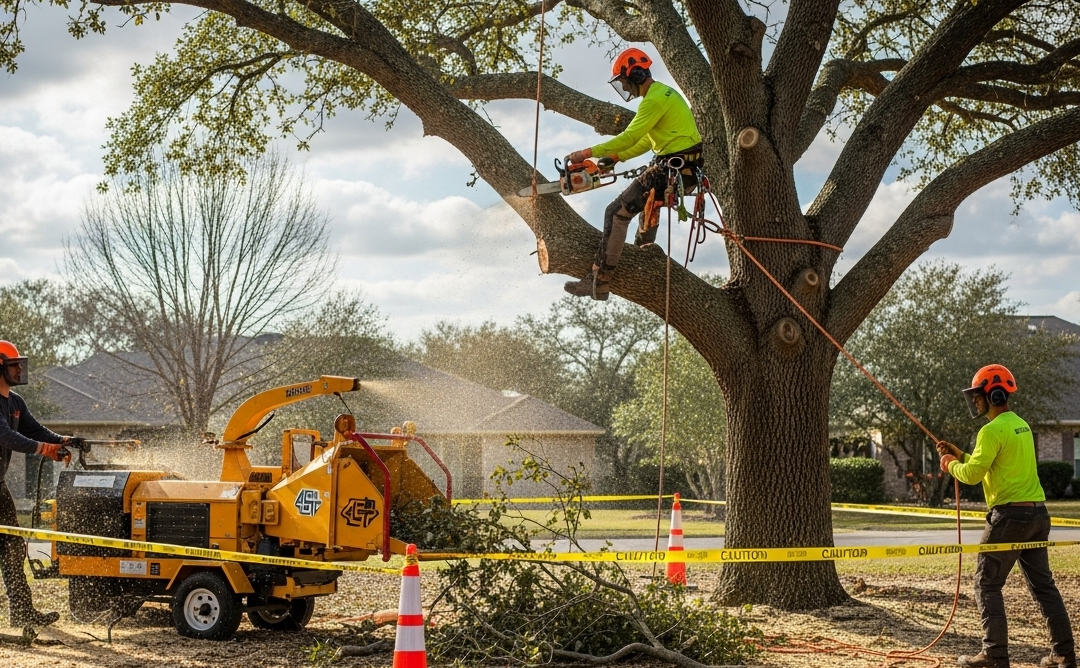When managing mature trees in urban or residential regions of Malaysia, the process is significantly more intricate than merely performing a straightforward cut. The interplay of dense tropical hardwoods, regular rainfall, and stringent local council regulations necessitates meticulous planning and execution that cannot be overlooked.
Below are five crucial, distinct recommendations to guarantee that your tree-cutting endeavor is safe, adheres to regulations, and is environmentally responsible.
Prioritize Professional Risk Assessment and Fall Zone Planning
Before a single branch is touched, a thorough assessment is crucial. Given the frequent downpours and strong winds in Malaysia, many trees may have hidden structural weaknesses or root rot that isn’t visible at ground level.
-
Assessment Checklist:
-
Determine the tree’s overall health and lean.
-
Identify all potential hazards: proximity to homes, utility lines (TNB and others), walls, or perimeter fences.
-
Fall Zone: In high-density areas, professional arborists use rigging and controlled sectional dismantling (cutting in pieces) instead of directional felling (cutting the whole tree at once) to manage the descent of every single piece, ensuring zero damage to surrounding property.
-
Always Verify Local Council (PBT) Permit Requirements
In Malaysia, cutting down or even pruning certain large or matured trees—especially those on private property but visible from the street—is strictly regulated by your local authority (Pihak Berkuasa Tempatan or PBT), such as DBKL, MBSJ, or MPPJ.
-
The Law: Most PBTs require a permit for trees above a certain trunk diameter (often 80cm) or specific heritage species.
-
The Consequence: Non-compliance can lead to hefty fines, with some councils imposing penalties of up to tens of thousands of Ringgit, as removing a protected tree without permission is an offense under local by-laws. Always check with your local council’s landscape or planning department before starting work.
Mandate the Full Tropical Safety Gear Checklist
The high humidity and heat in Malaysia can tempt workers to skip proper Personal Protective Equipment (PPE), but this is a serious mistake, especially when handling powerful equipment like chainsaws.
-
-
Essential PPE (No Compromises):
Head Protection: ANSI-approved helmet with a face shield/mesh visor.
- Limb Protection: Cut-resistant chainsaw chaps or trousers (critical for protecting against chain kickback).
- Footwear: Steel-toed or reinforced safety boots with strong ankle support for navigating uneven ground and dropping debris.
- Hearing Protection: Earplugs or earmuffs to prevent long-term damage from chainsaw noise.
-
Implement a Clear Communication and Retreat Plan
Noise, limited visibility, and the dynamic nature of tree work mean that verbal communication is often ineffective or impossible. A clear, pre-agreed signaling system is vital for the safety of the entire crew and anyone in the vicinity.
-
Signals: Establish hand or whistle signals for crucial commands: Stop, Stand Clear, Pull Line, and Tree Falling.
-
Designated Roles: Every team member must have a defined role (e.g., climber, ground crew, spotter/lookout).
-
Safe Retreat: For full tree felling, establish a pre-planned retreat path that moves away from the fall direction at a 45-degree angle. This ensures the team is clear of the stump and the inevitable kickback of the log.
Responsible Disposal and Wood Recycling
The sheer volume of wood waste generated by tree cutting can overwhelm municipal trash services. Being responsible for the debris is part of the job, especially given Malaysia’s focus on sustainable waste management.
-
Reduce, Reuse, Recycle:
-
Chipping: Use a powerful wood chipper to turn smaller branches into mulch, which can be reused in your garden to suppress weeds and retain soil moisture.
-
Timber: Large trunk pieces can be seasoned and sold to local sawmills, furniture makers, or for landscaping projects.
-
Stump: Determine if the stump will be ground down (stump grinding) to prevent regrowth and make the area usable, or if it will be left for natural decay.
-
By adhering to these five distinct areas—risk, regulation, equipment, communication, and disposal—you ensure that the tree cutting operation is not only successful but also professional and safe for everyone involved.
Conclusion
In the demanding environment of Malaysian tree-cutting, the successful completion of a project is measured not just by the tree’s removal, but by the adherence to strict safety standards and local regulations.
The five key tips provided—focusing on professional risk assessment, mandatory local council (PBT) permits, non-negotiable PPE, a clear communication plan, and responsible debris disposal—are the foundation of any ethical and professional operation.
Never compromise on safety or compliance. Given the high risks posed by large, tropical hardwoods and the heavy fines for violating PBT by-laws, engaging a certified arborist who understands the local environment and legal landscape is the single most critical decision to protect your property, your neighbours, and your investment. Tree cutting is a specialized job; ensure it is treated as one.

